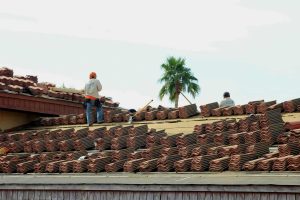Selecting the right roofing material is a crucial decision for any homeowner. Your roof is your home’s first line of defense against the elements, and the material you choose will impact your home’s durability, energy efficiency, and overall aesthetic. This blog post will guide you through the most common roofing materials: metal, tile, shingle, and flat roof systems, helping you make an informed decision for your next roofing project.
Metal Roofing
Metal roofs are known for their exceptional longevity and durability. They can withstand harsh weather conditions, including high winds, hail, and heavy snowfall. Metal roofs are also fire-resistant and low-maintenance, making them a popular choice for homeowners looking for a long-term investment. However, metal roofs can be more expensive upfront compared to other options.
Tile Roofing
Tile roofs offer a classic and elegant look, adding significant curb appeal to your home. They are incredibly durable and can last for decades with proper care. Tile roofs are also fire-resistant and resistant to rot and insect damage. However, tile roofs are one of the heaviest roofing materials, requiring a strong roof structure to support their weight. Additionally, tile roofs can be quite expensive to install.
Shingle Roofing
Asphalt shingles are the most popular roofing material in America due to their affordability and ease of installation. They come in a variety of styles and colors to complement any home’s architectural style. However, asphalt shingles have a shorter lifespan compared to other materials, typically lasting 15-30 years. They are also more susceptible to damage from wind, hail, and extreme weather events.
Flat Roof Systems
Flat roofs are a common choice for commercial buildings, but they are also becoming increasingly popular for residential applications. Flat roofs offer a modern aesthetic and can be used to create unique outdoor living spaces like rooftop patios. There are several types of flat roof materials available, including modified bitumen, TPO (Thermoplastic Polyolefin), and PVC (polyvinyl chloride). Flat roofs require proper drainage systems to prevent water pooling and leaks.
Choosing the Right Material for You
The best roofing material for your home will depend on a number of factors, including your budget, climate, desired lifespan, and aesthetic preferences. Here are some additional considerations:
- Climate: Consider the weather conditions in your area. If you live in a region with hot and sunny weather, metal roofs or reflective tiles can be a good option due to their ability to reflect sunlight and heat, helping to keep your attic cooler and reducing energy costs. Asphalt shingles, on the other hand, can absorb more heat, making your attic hotter.
- Style: Choose a roofing material that complements the architectural style of your home. For example, shingles would give a more classic look while a metal or flat roof would give a more modern look.
- Maintenance: Consider how much time and effort you are willing to invest in roof maintenance. Metal and tile roofs require minimal maintenance, while shingle roofs may require periodic repairs.
- Roof Pitch: The slope of your roof will also influence your material options. Flat roofs require specific materials, while steeper pitches can accommodate a wider range of choices.
Consulting with a Roofing Professional
No matter which roofing material you choose, it is important to consult with a qualified roofing professional for an inspection and estimate. We can assess your specific needs and recommend the best material for your home. We can also provide you with information on the installation process, expected costs, and maintenance requirements.




